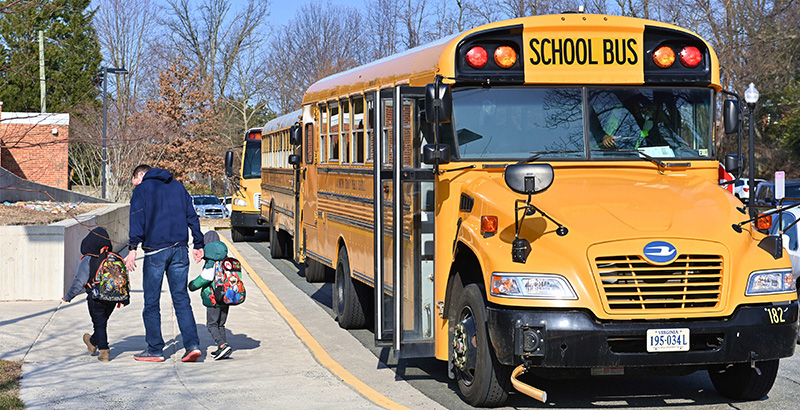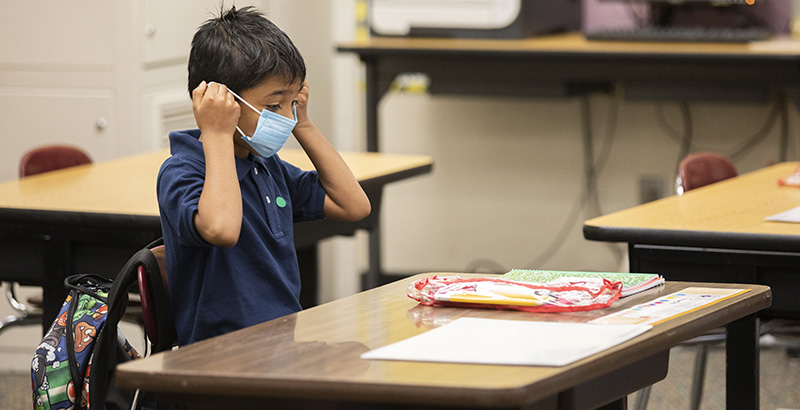The Week in COVID & Education Policy: Studying COVID Transmission on School Buses, Conflicting Recommendations About Student Masks & 13 More Key Updates

This is our weekly briefing on how the pandemic is shaping schools and education policy, vetted, as always, by AEI Visiting Fellow John Bailey. Click here to see the full archive. Get this weekly roundup, as well as rolling daily updates, delivered straight to your inbox — sign up for The 74 Newsletter.
COVID-19 Transmission Risk During School Bus Transportation: “Universal testing and contact tracing revealed no transmission linked to bus transportation” in a new study in the Journal of School Health.
- “An independent Virginia school monitored 1,154 students with asymptomatic PCR testing every 2 weeks initially and later every week from August 28, 2020-March 19, 2021, during highest community transmission.”
- “Fifteen buses served 462 students while operating at near capacity of 2 students in every seat, using a physical distancing minimum of 2.5 feet, universal masking and simple ventilation techniques.”
- “There were 39 infectious COVID-19 cases who were present on buses during the study period, which resulted in the quarantine of 52 students. Universal testing and contact tracing revealed no transmission linked to bus transportation.”

July 23, 2021 — The Big Three
Schools Can Reopen Safely for In-person Learning: A new report from Resolve to Save Lives — an organization led by former Centers for Disease Control and Prevention Director Tom Frieden — reviews the body of scientific evidence and concludes that schools can reopen safely for in-person learning if using multiple protection measures.
- “Children also spread COVID-19 less than adults, and schools have not been major drivers of community transmission — especially when protection measures are in place. Studies of schools in Australia and Europe found that the few outbreaks that were associated with schools typically involved 10 cases or fewer.”
- “Schools must reopen and stay open to avoid the cascade of societal burdens caused by remote schooling, as well as further educational, economic, and social damage that closures cause,” said Dr. Tom Frieden, president and CEO of Resolve to Save Lives, an initiative of Vital Strategies. “Keeping schools open is possible, but it is crucial that they implement a series of layered protections.”
- “Closing schools for in-person learning is deeply detrimental to the education and physical and mental health of children, as well as to the health and function of society.”
- “Abundant evidence shows that transmission and risk of outbreaks in schools can be reduced using layered mitigation measures” including promoting vaccination; consistent and correct mask use; ventilation; physical distancing; screening testing and contact tracing to promptly identify cases, clusters and outbreaks; handwashing and respiratory etiquette; staying home when sick and getting tested; cleaning and disinfection.

American Academy of Pediatrics Recommends Masks in Schools for Everyone Over Age 2, Regardless of Vaccinations: Updated guidance
- The pediatricians’ group cites these reasons for recommending masks: A “significant proportion of the student population is not yet eligible for vaccination; masking protects those who are not vaccinated against COVID-19 and reduces transmission; and potential difficulty in monitoring or enforcing mask policies for those who are not vaccinated.”
- This puts the academy at odds with the CDC, which advised that fully vaccinated students, teachers and staff don’t need to wear masks at school. There are already reports of pressure mounting on the CDC to revise that guidance.
- Additional highlights:
- “The AAP believes that, at this point in the pandemic, given what we know about low rates of in-school transmission when proper prevention measures are used, together with the availability of effective vaccines for those age 12 years and up, that the benefits of in-person school outweigh the risks in almost all circumstances.”
- “Schools must continue to take a multi-pronged, layered approach to protect students, teachers and staff (i.e., vaccination, universal mask use, ventilation, testing, quarantining, and cleaning and disinfecting). Combining these layers of protection will make in-person learning safe and possible.”
- Related: Youth Vaccination Rates Plummet, Reigniting Debates Over Masks in School
UK Will Not Offer COVID-19 Vaccine to Children Unless They Are Vulnerable: Children in the UK will get a COVID-19 vaccine only if they are over 12 and extremely vulnerable, or live with someone at risk.
- Joint Committee on Vaccination and Immunisation (JCVI) Statement:
- “Until more data become available, JCVI does not currently advise routine universal vaccination of children and young people less than 18 years of age.”
- “The health benefits in this population are small, and the benefits to the wider population are highly uncertain. At this time, JCVI is of the view that the health benefits of universal vaccination in children and young people below the age of 18 years do not outweigh the potential risks.”
- “The decision has split scientists, many of whom had expected the Pfizer vaccine to be given the green light for over-12s,” The Guardian reports.
- “There does seem to be a link with vaccines and myocarditis, but it’s very mild and very rare — but with COVID, there is a risk of long COVID,” one virologist said.
City & State News
Alabama: Is sponsoring a TikTok competition to promote vaccines among young people. To participate, contestants must submit a TikTok video showing themselves getting vaccinated or include a creative message explaining, “This is why I got vaccinated.” All videos must tag @alcovidvaccine, #getvaccinatedAL and #ADPH.”
Arkansas: Researchers: Virus surge a ‘raging forest fire’ in Arkansas. Via the Associated Press
- A model by the University of Arkansas for Medical Sciences’ Fay W. Boozman College of Public Health projected a daily average of 1,039 new cases over the next week. The model also predicted an average increase of 169 new cases per day in children under the age of 17.
- “Dr. Jose Romero, the state’s health secretary, said he was concerned about the possibility of a “surge on top of this surge” when school begins this fall. “I expect to see this year significant outbreaks within the school system. … What’s already telling me that’s going to happen are the number of day care closures that have occurred because of outbreaks occurring, and camp exposures and closures occurring.”
Washington, D.C.: CityBridge launched CityTutor DC, which is partnering with schools, tutoring providers, institutes of higher education and civic partners to expand the scope and impact of quality tutoring opportunities for D.C.’s students.
- “They aim to support 10,000 kindergarten through eighth-grade public school students with high-impact tutoring.”
- A database lists available tutors, and a resource bank has information for schools and families.
Georgia: How Cobb Schools plans to use its American Rescue Plan funding, which includes:
- $28.3 million to be used to offset cuts to the Quality Basic Education formula;
- $4.4 million for sanitation and cleaning of facilities;
- $1 million for additional Cobb Virtual Academy teachers to accommodate a growth in enrollment; and
- $25 million in technology purchases to assist in classroom instruction
North Carolina: Gov. Roy Cooper said K-8 students and teachers should wear masks in schools.
Rhode Island: Six state-run COVID-19 testing sites for school communities to close at the end of July.
Tennessee: The state education department announced 29 new virtual schools, bringing the total to 57.
Wisconsin: How Milwaukee Public Schools plans to use its rescue plan funding which includes:
- $48 million for air-temperature controls
- $7 million to build outdoor classrooms
- $13.6 million for mental health support
- $9.4 million for social and emotional learning
- $2 million for exercise stations and ropes courses
Federal Updates
Child Tax Credit: White House Fact Sheet
- The Department of Treasury estimates that $15 billion was distributed last week to tens of millions of working families with 60 million children.
- The 86 percent of families using direct deposit will receive their child payment July 15, and the 15th of every month for the rest of 2021.
- The American Rescue Plan is providing the largest-ever child tax credit — increasing from $2,000 to $3,000 for each child between the ages of 6 and 17, and to $3,600 for each child under the age of 6.
- The White House launched ChildTaxCredit.gov — a one-stop shop in English and Spanish for user-friendly information, including a step-by-step guide to using the non-filer portal in multiple languages.
- Via The Atlantic: “But an estimated 4 million to 8 million eligible children are at risk of missing out, because their parents or guardians do not need to file taxes or are not filing taxes — and because they might not even know the complicated, obscure-sounding and scarcely advertised policy exists.”
COVID-19 Research
Children and COVID-19: State-Level Data Report: Via AAP
- As of July 8, over 4.06 million children have tested positive for COVID-19.
- Children made up between 6 and 19.9 percent of total state tests, and between 4.9 and 34.9 percent of children tested tested positive.
- Children were 1.3 to 3.6 percent of total reported hospitalizations, and between 0.1 and 1.9 percent of all child COVID-19 cases resulted in hospitalization.
- Children were 0 to 0.25 percent of all COVID-19 deaths.
Well-Being Gap Between Remote, In-Person High School Learning: New study
- “The researchers had given a 10-question Character Lab Student Thriving Index survey to 6,576 high-schoolers enrolled at Orange County public schools in Florida.”
- “High school students taking remote classes had lower social, emotional and academic well-being survey scores compared with high-schoolers who attended in person during the pandemic.”
- “The thriving gap was consistent across gender, race/ethnicity and socioeconomic status — and even small effects are noteworthy when they impact millions of individuals.”
- “On a 100-point scale, in-person students were rated higher than remote students on levels of social well-being (77.2 versus 74.8), emotional well-being (57.4 versus 55.7) and academic well-being (78.4 versus 77.3).”
- More from The 74: High Schoolers Who Took Remote Classes During Pandemic Experienced a “Thriving Gap,” According to Duckworth-Led Study
Viewpoints
Teacher Survey: From EdChoice/Morning Consult: Read the quarterly report, briefing and cross tabs with 251 pages of data
- Teachers continue to be more likely to think the vaccine should be mandatory for themselves than for students.
- Three-fourths of teachers have already been vaccinated. Teachers are also more likely than school parents to already have their children vaccinated.
- Nearly all teachers are comfortable returning to school in person right now.
As Schools Recover, We Must Sustain Innovations that Have Proven Successful During COVID-19: Via former Massachusetts Gov. Jane Swift
- “Parental ingenuity, combined with the creativity of our educators, businesses and community leaders, led to new instructional settings like learning pods. While some philanthropic support extended those innovations to a broad swath of children, we often saw that these effective learning models were not available to those with fewer financial resources.”
- “Our priority as leaders must be getting the innovations which have proven effective during the pandemic extended to all students and families. Educators will need our support in rebuilding trust with parents as well as centering equity in their policies and practices after a year of both school closures and anti-racism reckoning.”
Steps to Protect Student Privacy & Support Equity in the New School Year: Via Center for Democracy and Technology
Technology Can Be a Powerful Force for Educational Equity If We Want It to Be: “Technology can be a powerful tool for fostering student ownership of learning, differentiating and personalizing instruction, and making teaching and learning more accessible,” writes Wendy Kopp.
Catholic Virtual Partners with U.S. Dioceses to Create Online Academies for 2021-22: Press Release
New Virtual Offering: Environmental advocate and author Suzy Amis Cameron, and noted filmmaker and explorer James Cameron, announce a partnership with public school districts with their online learning platform, MUSE Virtual.
Social-Emotional Learning Toolkit for State and District Leaders: The Council of Chief State School Officers, Collaborative for Academic, Social and Emotional Learning, and American Institutes for Research released a toolkit to support leaders who are interested in explicitly incorporating social and emotional learning within a multi-tiered system of supports framework.
- The council also partnered with the Healthy Schools Campaign and the National Center for School Mental Health to create a guide for states on leveraging COVID relief funding and Medicaid to support student and staff well-being and connection.
…And on a Reflective Note
Be Curious, Not Judgmental: Via the philosopher Ted Lasso quoting Walt Whitman in this clip.
- “You know, Rupert, guys have underestimated me my entire life. And for years, I never understood why. It used to really bother me.”
- “But then one day, I was driving my little boy to school and I saw this quote by Walt Whitman, and it was painted on the wall there. It said, “Be curious, not judgmental.” I like that.”
- “So I get back in my car and I’m driving to work, and all of a sudden it hits me. All them fellas that used to belittle me, not a single one of them were curious.”
- “You know, they thought they had everything all figured out. So they judged everything, and they judged everyone.”
- “And I realized that their underestimating me… who I was had nothing to do with it. ‘Cause if they were curious, they would’ve asked questions.”
ICYMI @The74
Weekend Reads: In case you missed them, our top five stories of the week:
- Leadership: Twitter Breaks, Meditative Walks, Security Guards: How School Leaders are Responding to an Unsettling Season of Public Outrage
- Mental Health: Fearing a ‘Second Pandemic’ of Student Trauma, School Leaders Are Doubling Down on Mental Health First Aid Training
- COVID Recovery: Helping Students Learn at Their Own Pace: Why Some Ohio Schools Are Adopting a ‘Mastery’ Approach in Hopes of Closing COVID Learning Gaps
- Higher Education: DeBaun: Virtual Advising Can Combat COVID Melt and Ensure HS Students Make it to College. 3 Steps Schools Can Take
- Student Health: Youth Vaccination Rates Plummet, Reigniting Debates Over Masks in School
Disclosure: John Bailey is an adviser to the Walton Family Foundation, which provides financial support to The 74.
Get stories like these delivered straight to your inbox. Sign up for The 74 Newsletter

;)
